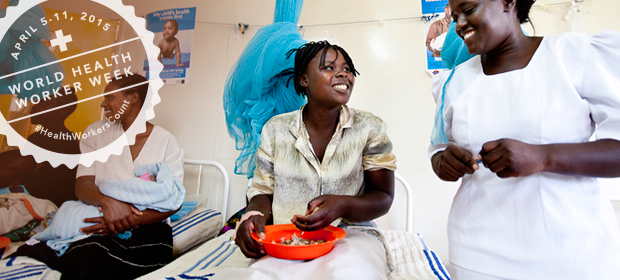Where We Work
See our interactive map


Last week, diverse organizations came together to honor the heroic and lifesaving work of frontline health workers in their communities and beyond, and advocate for health workforce strengthening to be a central priority in the global health agenda moving forward.
Our common, heartfelt gratitude and respect for frontline health workers was undoubtedly the mobilizing force behind these passionate and concerted advocacy efforts, and World Health Worker Week 2015 provided the unique opportunity to collectively share our sentiments and work together towards these shared goals.
The first World Health Worker Week in 2013 was built on mobilizing a shared recognition that improving access to skilled, motivated, and supported health workers was absolutely central to achieving universal health coverage (UHC).
Health workers are the backbone of all global health goals.
Two years later, World Health Worker Week 2015 further built on this theme to stress how health workers were “the backbone of all global health goals”—from achieving an AIDS-free Generation, combatting maternal and child mortality, defeating Ebola and other infectious diseases, and, indeed, underpinning the resilient health systems we need to achieve universal health coverage.
This year’s official poster for World Health Worker Week, designed by Karen Melton at IntraHealth International, creatively illustrated the foundational role health workers play in achieving these goals.
Numerous articles published by partners in recognition of WHWW highlighted the tenacity of health workers in accelerating progress towards achieving critical global health priorities.
In Health Workers on Ebola Frontlines Serve Countries, Risk Own Lives, a feature story published by the World Bank for WHWW, we learned about the tireless efforts of local West African health workers in helping their countries reach zero Ebola cases, despite enormous risks, poor motivation, and ongoing shortages in essential protective equipment and training. To overcome these challenges and rebuild, the article emphasized the need for investment in “developing a national health workforce as part of a more resilient system.”
Similarly, in Health Workers Spotlight: Heroes in the Fight for an AIDS-Free Generation, the Elisabeth Glaser Pediatric AIDS Foundation (EGPAF) acknowledged how critical health workforce shortages have hindered efforts to prevent and treat pediatric HIV/AIDS, and highlighted how investments in bolstering the health workforce in Kenya, Malawi, and Rwanda have had a huge impact on bolstering sexual reproductive health services in these regions.
Finally, in 289,000 Reasons Why Health Workers Count for Mothers, IntraHealth International’s president and CEO Pape Gaye advocated for investments in helping developing countries “to train and deploy health workers where they are needed most”—especially in rural areas where health workers are largely inaccessible to women like Lala, Gaye’s sister who tragically lost her baby when she could not reach a hospital nearly 20 miles away during an emergency pregnancy complication
.We also learned during this week that health workers are not only the underpinning backbone of global health goals, but also a fervent voice on behalf of the communities they serve.
In Health Workers Speak, a Humans of New York-esque gallery featuring over 40 photos and quotes from health workers around the world, health workers themselves spoke passionately on their commitment to providing life-saving services at all odds.
Health workers are a fervent voice on behalf of the communities they serve.
Beautiful stories were also shared in A Day in the Life, an interactive map produced by the One Million Health Workers Campaign, Esri, and Direct Relief, showcasing the diverse roles community health workers play in improving health outcomes across Africa.
Inspired by these stories, leaders and health workforce advocates took to social media to express their deep appreciation for frontline health workers.
In a WHWW twitter chat organized by Johnson & Johnson on April 9th, over 300 organizations and individuals used the hashtag #HealthWorkersCount to express their gratitude for the indispensable role health workers play in communities they live and work in. Throughout the week, USAID and other US government agencies celebrated the contributions of health workers, and shared blogs highlighting what still needs to be done to achieve a sustainable and resilient global health workforce.
As a perfect capstone to this week, Save the Children Pakistan and partners hosted an awards ceremony honoring 36 lady health workers from different Pakistani districts for their life-saving work in improving maternal and child health outcomes in rural regions. Yasmeen Shahzad, a lady health worker from the Rawalpindi district, said that she felt incredibly motivated and “encouraged to work harder” after receiving her award.
With World Health Worker Week 2015 now come to a close, we feel inspired and energized to continue building the momentum we need to ensure health workforce remains a core priority of the global health and development agenda. We hope that organizations and individuals will use what they have learned from this week as a catalyst for the ongoing engagement and advocacy we need to ensure health workers around the world have the support they deserve.
This post originally appeared on the Frontline Health Workers Coalition blog.
Get the latest updates from the blog and eNews




